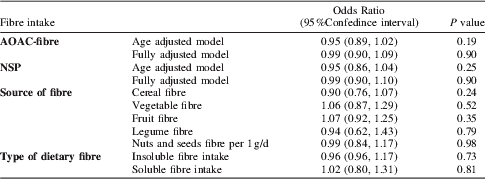There is global agreement that dietary guidelines should encourage consumption of a high fibre diet to prevent nutrition-related chronic diseases( 1 ). It is recognized that higher fibre diets are beneficial for individuals with type 2 diabetes (T2DM) and generally, observational studies indicate a negative association between dietary fibre intake and risk of incident T2DM( Reference Schulze, Schulz and Heidemann 2 ). However, there is less clarity around the optimal source or type of dietary fibre for prevention of T2DM. Therefore the current study explored the association between risk of T2DM and dietary fibre intake estimated by the Association of Official Analytical Chemists (AOAC) method (which includes resistant starch, non-starch polysaccharides (NSP) and lignin) and NSP values alone in addition to exploring fibre source and type (water soluble and insoluble). The UK Women Cohort's Study is a population-based prospective cohort of middle-aged women. From 35,372 women who completed a 217-item food frequency questionnaire (FFQ) at baseline, 12,149 women also completed a follow-up questionnaire after an average of 4 years. Participants who reported a history of diabetes at baseline and those with unfeasible energy intakes were excluded from the study leaving 114 women who reported having developed diabetes during the follow-up period and 11,982 women who remained free from diabetes. Total dietary fibre intake (g/day as AOAC or NSP fibre) and fibre from cereal, fruit, vegetable, legume and nuts and seed sources was calculated using the baseline FFQ data. Demographic and lifestyle variables were obtained from baseline. Logistic regression analysis was used to determine the relationship of baseline dietary fibre intake to risk of incident T2DM. Two models were run, an age-adjusted and a multivariable-adjusted model, which additionally included, energy intake, smoking status, adult weight change, socioeconomic status (professional, intermediate and manual), alcohol intake (g/day), physical activity level and family history of diabetes. Results in the Table are expressed as the odds of developing incident T2DM for each unit increment of dietary fibre consumed, which was 5 g/d (equivalent to 2 slices of wholemeal bread) for all fibre types except fibre from nuts and seeds which was 1 g/d. In the age-adjusted model, cereal fibre intake was significantly associated with a reduced risk of T2DM with a 17% reduction in odds for each 5 g/d increment consumed (95% CI 0.71, 0.98). For most multi-variable analyses, odds ratios were less than one (see Table), suggesting a lower risk of developing T2DM with higher intakes. However, wide confidence intervals indicated a lack of statistical significance.

These findings point towards a lower risk of developing T2DM in British women who consume diets high in fibre (particularly cereal fibre). However, the lack of statistical significance suggests either a weak relationship, high levels of dietary measurement error or may be a reflection of our relatively small number of cases.




